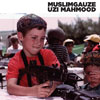 Towards the end of his career, Soleilmoon put in a request to the late Bryn Jones to put together some material that was conventional enough to allow some crossover into the electronic and dance scenes. This wasn’t an absurd request, because at this time his work more than flirted with dance and hip-hop beats, but often it was just as likely to slide into harsh, abrasive textures. The proposed 12" requested by the label was delivered as a 90 minute DAT, all of which is reproduced here. It is two discs of the most ass shaking, head-nodding material he ever did that conjures images of burka clad women shaking their asses, Miami bass style.
Towards the end of his career, Soleilmoon put in a request to the late Bryn Jones to put together some material that was conventional enough to allow some crossover into the electronic and dance scenes. This wasn’t an absurd request, because at this time his work more than flirted with dance and hip-hop beats, but often it was just as likely to slide into harsh, abrasive textures. The proposed 12" requested by the label was delivered as a 90 minute DAT, all of which is reproduced here. It is two discs of the most ass shaking, head-nodding material he ever did that conjures images of burka clad women shaking their asses, Miami bass style.
The original DAT was cut up and released as a 12" single of the same name (consisting of tracks 1, 5, 8, and 13), with two more being added to the release of Hussein Mahmood Jeeb Tehar Gass, but here it is being released in its entirety for the first time. Unsurprisingly, the material doesn’t sound like a conscious attempt by Jones to make headway into the clubs, but more an emphasis on the conventional elements of his sound; it’s unmistakably Muslimgauze.
The overall vibe of the album fits with the time it was released: the emphasis on hip-hop breakbeats goes along with the ambient dub and illbient scenes that were winding down at the time. However, while those two subgenres of subgenres were focused on mixing rhythms with otherwise sparse instrumentation, Jones is still more than happy to layer the tracks with various loops, albeit with a bit more restraint than usual. "Uzi Mahmood 3" for example is based on underlying raw vinyl surface noise, with subtle Middle Eastern singing and horns low in the mix, but slow, echo chamber hell reverberated dub beats up front. The emphasis is definitely on the beats, but not at the expense of other elements of the track.
Listening to both discs as a whole, it does seem pretty obvious that Jones hadn’t intended for this to be released unedited, because he recycles a lot of elements from track to track that, if spread across multiple albums or singles, wouldn’t be as notable, but back to back, it becomes obvious. Loops of record scratching, reggae organ stabs, and radar blip-like rhythms are recurring motifs throughout. For example, both "Uzi Mahmood 5" and "Uzi Mahmood 10" use the reggae organ stab sound, though the former is overtly dub influenced, while the latter goes the hip-hop route with loud, big drums and record scratching.
"Uzi Mahmood 1" fully embraces the hip-hop elements of the Muslimgauze sound, using the same record scratching over a slow Dr. Dre-esque beat and massive ass-shaking sub bass. The long "Uzi Mahmood 9" (and its alternate mix, "Uzi Mahmood 13") lifts a beat that could have been pulled off any early 1990s "positive" hip-hop album, but mixed with Jones penchant for erratic stop/start rhythms and layered abstraction, it takes on an entirely different character.
"Uzi Mahmood 7" is a slightly different beat, with a more subdued mix, pared down to the barest essentials and a very analog, blip-centric rhythm is far more electro than anything I’ve heard him do before. Also a bit out of left-field, "Uzi Mahmood 11" uses a raw drum ‘n bass inspired rhythm (albeit slower than others in the genre), that makes it stand out more than the other tracks here, as well as the other beat-centric releases out there.
Considering I have always favored the hip-hop rhythms of Muslimgauze compared to his more overtly Middle Eastern tracks, I definitely am pretty fond of what’s here. The tracks occasionally go on a little too long and get repetitive: I’m guessing the label usually edited them down on the traditional albums released, but perhaps it was Jones’ commentary on dance music, they are still rather solid. Muslimgauze releases have been far more harsh and abrasive compared to this one, but never does it descend into boring Starbucks "world music" faux ethnicity.
samples:
Read More

